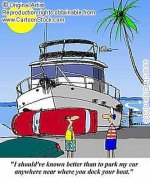rjmcnabb
New member
- Joined
- Sep 1, 2007
- Messages
- 159
- Reaction score
- 0
- C Dory Year
- 1999
- C Dory Model
- 16 Cruiser
- Vessel Name
- Luna
Hi Brats,
I need some advice or comment on my low speed handling problems!
Coming up to start docking manoeuvers needs a right turn into the aisle and then an immediate left turn into my slip, bringing the finger pier onto my port side. As I take that right, I have to be concerned about a big metal ring around the dock piling there, not to hit it directly-and not have my stern swing into it when I start the left turn. Things are pretty tight. The problem I seem to have is that I have so little steerage-way that the boat responds poorly, and is overcome easily by minor wind and current factors. Docking, usually solo but even when not, is a Keystone Kops scene. It seems that the bow blows off, the flat stern takes no bite on the water, and many movements seem almost random. I had similar trouble before with a Nimble Vagabond, even though it was a displacement Sharpie hull with more of the bow in the water, which I presumed would help the bow to respond more slowly to wind gusts, etc. People on the docks just say that it all takes practice (and some of them are impossibly slick.) Well enough, but most of them seem to have deep-V hulls. How much of an advantage does a deep-V hull offer in places like this? Is there enough of a keel effect in a deep-V to make a difference? Docking a 19-foot sail boat (dagger board down, or fixed keel) in these narrow confines is tight, but infinitely easier.
Am I just a long way down on the learning curve, or can Brats offer me advice about controlling slide and side-slip across the water?
On another tack, I had thought about an electric trolling motor as a bow thruster, and I saw the recent thread on that topic. I ran across a small ad recently, perhaps in an older copy of Pacific Yachting (BC,) for such a motor mounted on a V-shaped channel that could be fitted to the bow's cutwater. The interesting claim was that there were no fasteners below the waterline, and I guess that on plane the electric motor would be out of the water. There did not seem any means to move the motor up, so I guess it would have to take the assault of water up to 8-9 knots until a C-Dory 22 can come up onto plane.
Any pearls (wisdom or otherwise) will be greatly appreciated. Thanks.
Rod
I need some advice or comment on my low speed handling problems!
Coming up to start docking manoeuvers needs a right turn into the aisle and then an immediate left turn into my slip, bringing the finger pier onto my port side. As I take that right, I have to be concerned about a big metal ring around the dock piling there, not to hit it directly-and not have my stern swing into it when I start the left turn. Things are pretty tight. The problem I seem to have is that I have so little steerage-way that the boat responds poorly, and is overcome easily by minor wind and current factors. Docking, usually solo but even when not, is a Keystone Kops scene. It seems that the bow blows off, the flat stern takes no bite on the water, and many movements seem almost random. I had similar trouble before with a Nimble Vagabond, even though it was a displacement Sharpie hull with more of the bow in the water, which I presumed would help the bow to respond more slowly to wind gusts, etc. People on the docks just say that it all takes practice (and some of them are impossibly slick.) Well enough, but most of them seem to have deep-V hulls. How much of an advantage does a deep-V hull offer in places like this? Is there enough of a keel effect in a deep-V to make a difference? Docking a 19-foot sail boat (dagger board down, or fixed keel) in these narrow confines is tight, but infinitely easier.
Am I just a long way down on the learning curve, or can Brats offer me advice about controlling slide and side-slip across the water?
On another tack, I had thought about an electric trolling motor as a bow thruster, and I saw the recent thread on that topic. I ran across a small ad recently, perhaps in an older copy of Pacific Yachting (BC,) for such a motor mounted on a V-shaped channel that could be fitted to the bow's cutwater. The interesting claim was that there were no fasteners below the waterline, and I guess that on plane the electric motor would be out of the water. There did not seem any means to move the motor up, so I guess it would have to take the assault of water up to 8-9 knots until a C-Dory 22 can come up onto plane.
Any pearls (wisdom or otherwise) will be greatly appreciated. Thanks.
Rod

